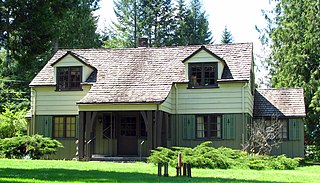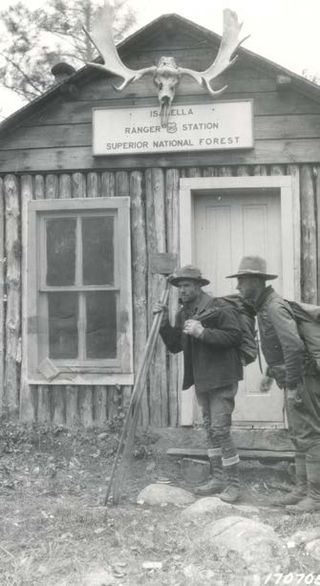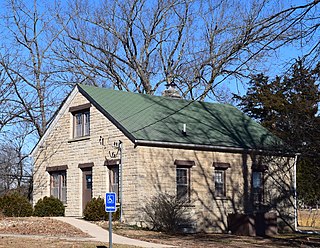
Clearwater National Forest with headquarters on the Nez Perce Reservation at Kamiah is located in North Central Idaho in the northwestern United States. The forest is bounded on the east by the state of Montana, on the north by the Idaho Panhandle National Forest, and on the south and west by the Nez Perce National Forest and Palouse Prairie.

The Lochsa River is in the northwestern United States, in the mountains of north central Idaho. It is one of two primary tributaries of the Middle Fork of the Clearwater River in the Clearwater National Forest. Lochsa is a Nez Perce word meaning rough water. The Salish name is Ep Smɫí, "It Has Salmon."

The Jackson Lake Ranger Station is the last Depression-era U.S. Forest Service ranger station in its original location in Grand Teton National Park. When first established, the park comprised only the mountainous terrain above Jackson Hole, while the remainder of what would eventually become the park was administered by the Forest Service as part of Teton National Forest. The Jackson Lake Station was built in 1933 as close as possible to Park Service property as possible as a kind of resistance to the park's expansion. The station was one of five Forest Service stations in the area, and was taken over by the National Park Service when Jackson Hole National Monument was established in 1943, later becoming an enlarged Grand Teton National Park. It is the only such station not to have been moved or altered by the Park Service.

The Zigzag Ranger Station is a Forest Service compound consisting of twenty rustic buildings located in Oregon's Mount Hood National Forest. It was built as the administrative headquarters for the Zigzag Ranger District. It is located in the small unincorporated community of Zigzag, Oregon. Many of the historic buildings were constructed by the Civilian Conservation Corps between 1933 and 1942. Today, the Forest Service still uses the ranger station as the Zigzag Ranger District headquarters. The ranger station is listed on the National Register of Historic Places.

The Isabella Ranger Station is a complex of 21 buildings in Stony River Township, Minnesota, United States, near the town of Isabella. It is located on Minnesota State Highway 1 about one mile east of Isabella. The complex is listed on the National Register of Historic Places for its association with New Deal federal relief construction.
Architects of the United States Forest Service are credited with the design of many buildings and other structures in National Forests. Some of these are listed on the National Register of Historic Places due to the significance of their architecture. A number of these architectural works are attributed to architectural groups within the Forest Service rather than to any individual architect. Architecture groups or sections were formed within engineering divisions of many of the regional offices of the Forest Service and developed regional styles.
Sycamore Ranger Station, also known as Sycamore Work Center and as Sycamore Administrative Site, in Prescott National Forest near Camp Verde, Arizona was built in 1940 by the Civilian Conservation Corps. It was listed on the National Register of Historic Places in 1993 for its architecture, which includes vernacular, national(?), and other styles. It was designed by architects of the United States Forest Service. It served historically as institutional housing and as government office space. The NRHP listing included two contributing buildings on 2.5 acres (1.0 ha).
The Atlanta Ranger Station, also known as Atlanta Guard Station, is a 24 acres (9.7 ha) historic district in Boise National Forest in Atlanta, Idaho that was listed on the National Register of Historic Places in 2003. It includes 10 contributing buildings dating as far back as 1933. The complex was built by the Civilian Conservation Corps and designed by the USDA Forest Service, and includes Forest Service R-4 Standard and other architecture. The listing included ten contributing buildings.

The Bergland Administrative Site, also known as the Bergland Ranger Station, is a government administrative complex consisting of six buildings located along M-28 in Bergland, Michigan. It was listed on the National Register of Historic Places in 2005, and currently houses the Bergland Cultural & Heritage Center and The Bergland/Matchwood Historical Society Museum.

The Ant Flat Ranger Station is a site on the National Register of Historic Places located 2 miles south of Fortine, Montana in Kootenai National Forest. It was added to the Register on December 30, 1996.

The Gasquet Ranger Station Historic District comprises a compound of buildings associated with the Gasquet Ranger District of Six Rivers National Forest. The U.S. Forest Service complex is located along the Smith River on U.S. Route 199 in Del Norte County, California, within Smith River National Recreation Area. Most of the buildings were built by the Civilian Conservation Corps between 1933 and 1939. Seven buildings and a rock wall remain of the CCC-built structures. The district office, the assistant district ranger's residence, a warehouse, two garages and a fuel house were built in the Forest Service rustic style that prevailed at the time. The style is reflected in distinctive detailing, including a recurring pine tree cut-out logo that appears on gables and shutters.

Crossett Experimental Forest is an experimental forest operated by the Southern Research Station (SRS) of the United States Forest Service in Ashley County, Arkansas. It is managed out of the SRS office in Monticello, Arkansas, with onsite facilities about 6.8 miles (10.9 km) south of Crossett, Arkansas off Arkansas Highway 133.

Townshend State Park is a state park in Townshend, Vermont. Embedded within Townshend State Forest, the park provides a camping facility and hiking trails for accessing Bald Mountain. The park's facilities were developed by the Civilian Conservation Corps in the 1930s, and are listed on the National Register of Historic Places for their well-preserved state.

Rolla Ranger Station Historic District is a historic ranger station and national historic district located at Mark Twain National Forest near Rolla, Phelps County, Missouri. The station includes five frame and limestone buildings constructed by the Civilian Conservation Corps (CCC) during 1937 and 1938. They were built under the supervision of a Works Progress Administration (WPA) project. They are a ranger's office, dwelling, garage, warehouse and oil house. The ranger's office and dwelling are 1 1/2-story, Colonial Revival influenced buildings.
Winona Ranger Station Historic District is a historic ranger station and national historic district located in Mark Twain National Forest near Winona, Shannon County, Missouri. The district encompasses four contributing buildings, associated with a ranger station constructed by the Civilian Conservation Corps (CCC) under the supervision of a Works Progress Administration (WPA) project. It developed between 1938 and 1938 and includes 1+1⁄2-story, Colonial Revival style ranger's dwelling, garage, warehouse, and oil house.
The Snyder Guard Station by the Moyie River in Kaniksu National Forest, in the vicinity of Eastport, Idaho, dates from 1908. A historic district encompassing the station was listed on the National Register of Historic Places as Snyder Guard Station Historical District in 1983. The listed area included nine contributing buildings.
The Chamberlain Ranger Station Historic District, also known as the Chamberlain Guard Station, is located in the Frank Church-River of No Return Wilderness within Payette National Forest in Idaho County, Idaho. It was listed on the National Register of Historic Places in 2004.
The Cold Meadows Guard Station is a ranger station located northeast of McCall, Idaho in the Frank Church-River of No Return Wilderness and the Payette National Forest. It was listed on the National Register of Historic Places in 1994.
The Krassel Ranger Station, near Yellow Pine, Idaho, was built in 1937. It was listed on the National Register of Historic Places in 1992. The listing included four contributing buildings, a contributing structure, and a contributing site on 6.2 acres (2.5 ha).













